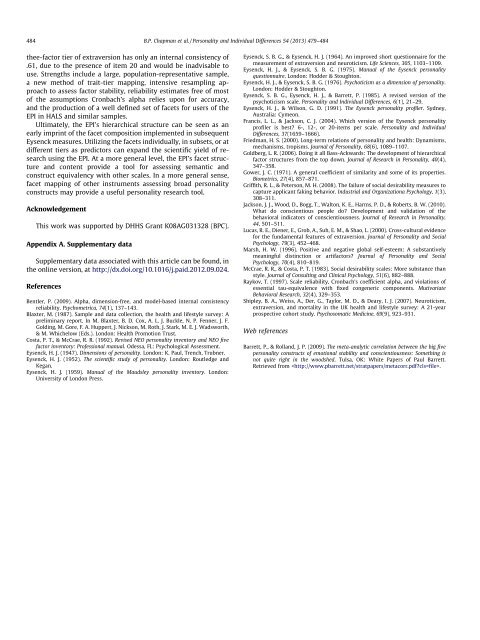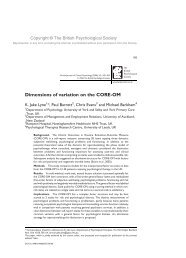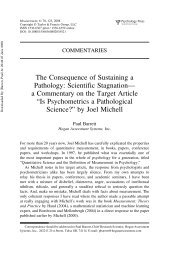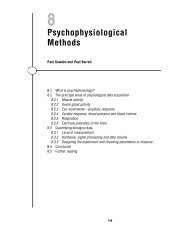103 - Paul Barrett
103 - Paul Barrett
103 - Paul Barrett
Create successful ePaper yourself
Turn your PDF publications into a flip-book with our unique Google optimized e-Paper software.
484 B.P. Chapman et al. / Personality and Individual Differences 54 (2013) 479–484<br />
thee-factor tier of extraversion has only an internal consistency of<br />
.61, due to the presence of item 20 and would be inadvisable to<br />
use. Strengths include a large, population-representative sample,<br />
a new method of trait-tier mapping, intensive resampling approach<br />
to assess factor stability, reliability estimates free of most<br />
of the assumptions Cronbach’s alpha relies upon for accuracy,<br />
and the production of a well defined set of facets for users of the<br />
EPI in HALS and similar samples.<br />
Ultimately, the EPI’s hierarchical structure can be seen as an<br />
early imprint of the facet composition implemented in subsequent<br />
Eysenck measures. Utilizing the facets individually, in subsets, or at<br />
different tiers as predictors can expand the scientific yield of research<br />
using the EPI. At a more general level, the EPI’s facet structure<br />
and content provide a tool for assessing semantic and<br />
construct equivalency with other scales. In a more general sense,<br />
facet mapping of other instruments assessing broad personality<br />
constructs may provide a useful personality research tool.<br />
Acknowledgement<br />
This work was supported by DHHS Grant K08AG031328 (BPC).<br />
Appendix A. Supplementary data<br />
Supplementary data associated with this article can be found, in<br />
the online version, at http://dx.doi.org/10.1016/j.paid.2012.09.024.<br />
References<br />
Bentler, P. (2009). Alpha, dimension-free, and model-based internal consistency<br />
reliability. Psychometrica, 74(1), 137–143.<br />
Blaxter, M. (1987). Sample and data collection, the health and lifestyle survey: A<br />
preliminary report. In M. Blaxter, B. D. Cox, A. L. J. Buckle, N. P. Fenner, J. F.<br />
Golding, M. Gore, F. A. Huppert, J. Nickson, M. Roth, J. Stark, M. E. J. Wadsworth,<br />
& M. Whichelow (Eds.). London: Health Promotion Trust.<br />
Costa, P. T., & McCrae, R. R. (1992). Revised NEO personality inventory and NEO five<br />
factor inventory: Professional manual. Odessa, FL: Psychological Assessment.<br />
Eysenck, H. J. (1947). Dimensions of personality. London: K. <strong>Paul</strong>, Trench, Trubner.<br />
Eysenck, H. J. (1952). The scientific study of personality. London: Routledge and<br />
Kegan.<br />
Eysenck, H. J. (1959). Manual of the Maudsley personality inventory. London:<br />
University of London Press.<br />
Eysenck, S. B. G., & Eysenck, H. J. (1964). An improved short questionnaire for the<br />
measurement of extraversion and neuroticism. Life Sciences, 305, 1<strong>103</strong>–1109.<br />
Eysenck, H. J., & Eysenck, S. B. G. (1975). Manual of the Eysenck personality<br />
questionnaire. London: Hodder & Stoughton.<br />
Eysenck, H. J., & Eysenck, S. B. G. (1976). Psychoticism as a dimension of personality.<br />
London: Hodder & Stoughton.<br />
Eysenck, S. B. G., Eysenck, H. J., & <strong>Barrett</strong>, P. (1985). A revised version of the<br />
psychoticism scale. Personality and Individual Differences, 6(1), 21–29.<br />
Eysenck, H. J., & Wilson, G. D. (1991). The Eysenck personality profiler. Sydney,<br />
Australia: Cymeon.<br />
Francis, L. L., & Jackson, C. J. (2004). Which version of the Eysenck personality<br />
profiler is best 6-, 12-, or 20-items per scale. Personality and Individual<br />
Differences, 37(1659–1666).<br />
Friedman, H. S. (2000). Long-term relations of personality and health: Dynamisms,<br />
mechanisms, tropisms. Journal of Personality, 68(6), 1089–1107.<br />
Goldberg, L. R. (2006). Doing it all Bass-Ackwards: The development of hierarchical<br />
factor structures from the top down. Journal of Research in Personality, 40(4),<br />
347–358.<br />
Gower, J. C. (1971). A general coefficient of similarity and some of its properties.<br />
Biometrics, 27(4), 857–871.<br />
Griffith, R. L., & Peterson, M. H. (2008). The failure of social desirability measures to<br />
capture applicant faking behavior. Industrial and Organizationa Psychology, 1(3),<br />
308–311.<br />
Jackson, J. J., Wood, D., Bogg, T., Walton, K. E., Harms, P. D., & Roberts, B. W. (2010).<br />
What do conscientious people do Development and validation of the<br />
behavioral indicators of conscientiousness. Journal of Research in Personality,<br />
44, 501–511.<br />
Lucas, R. E., Diener, E., Grob, A., Suh, E. M., & Shao, L. (2000). Cross-cultural evidence<br />
for the fundamental features of extraversion. Journal of Personality and Social<br />
Psychology, 79(3), 452–468.<br />
Marsh, H. W. (1996). Positive and negative global self-esteem: A substantively<br />
meaningful distinction or artifactors Journal of Personality and Social<br />
Psychology, 70(4), 810–819.<br />
McCrae, R. R., & Costa, P. T. (1983). Social desirability scales: More substance than<br />
style. Journal of Consulting and Clinical Psychology, 51(6), 882–888.<br />
Raykov, T. (1997). Scale reliability, Cronbach’s coefficient alpha, and violations of<br />
essential tau-equivalence with fixed congeneric components. Mutivariate<br />
Behavioral Research, 32(4), 329–353.<br />
Shipley, B. A., Weiss, A., Der, G., Taylor, M. D., & Deary, I. J. (2007). Neuroticism,<br />
extraversion, and mortality in the UK health and lifestyle survey: A 21-year<br />
prospective cohort study. Psychosomatic Medicine, 69(9), 923–931.<br />
Web references<br />
<strong>Barrett</strong>, P., & Rolland, J. P. (2009). The meta-analytic correlation between the big five<br />
personality constructs of emotional stability and conscientiousness: Something is<br />
not quite right in the woodshed. Tulsa, OK: White Papers of <strong>Paul</strong> <strong>Barrett</strong>.<br />
Retrieved from .












